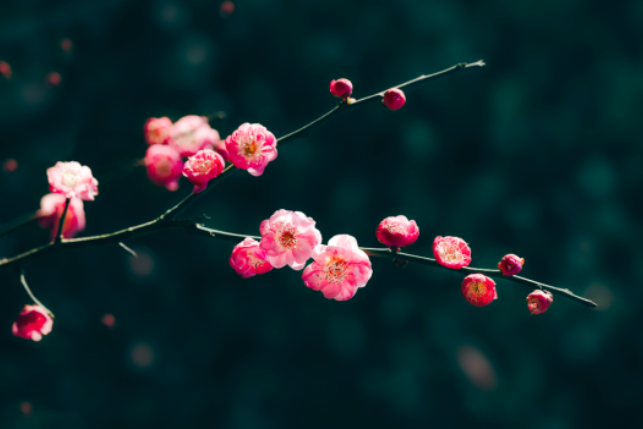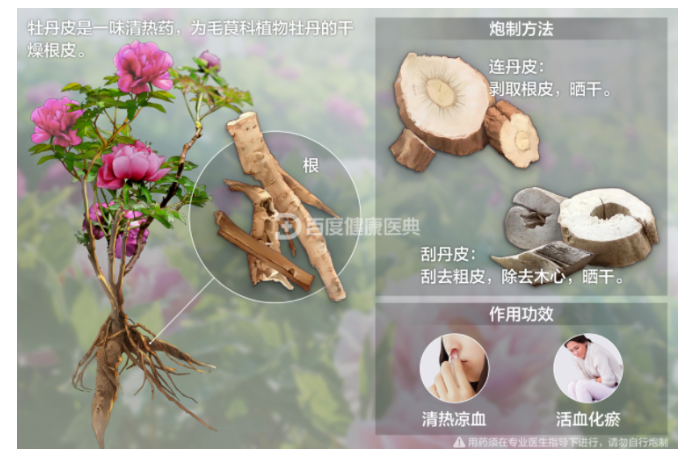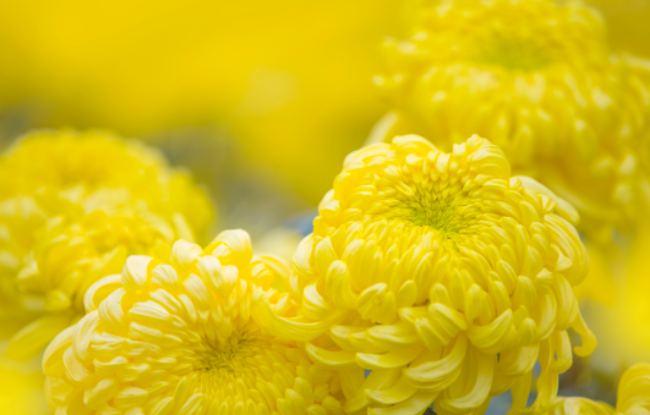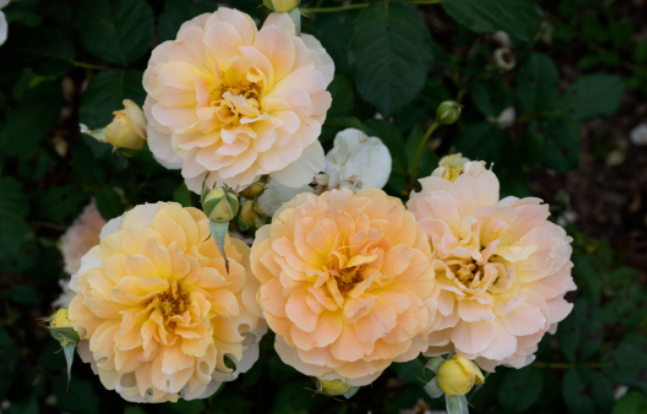最能代表中国的8种花,用英文怎么说?
阅读量:
人间最美四月天,当是时,春色过半,百花次第争开。
春天是花的季节,最能代表中国的8种花,你都认识吗?
梅花
Plum blossom
无意苦争春,一任群芳妒。
零落成泥碾作尘,只有香如故。
She endures while awaiting spring,
The envy of the other flowers.
Her petals may be ground into mud,
But her fragrance will endure.
——【宋】陆游《卜算子·咏梅》

梅、兰、竹、菊被古人称为四君子。尤其是梅花,一直为国人赞赏。
The plum blossom, orchid, bamboo and chrysanthemum were called by the ancient Chinese the "Four Gentlemen". The plum blossom was especially appreciated.
在寒冷的时岁,梅花竞相绽放。自古以来,梅花就是中国人坚贞不屈、迎难而上、高风亮节的生动写照。文人爱梅,因为这代表着自强不息,象征着不与世俗同流合污。以梅自勉,以花自喻,这是古代文人的乐趣。
In the cold of water, only plum trees bloom brightly. Since ancient times, plum blossoms have been believed to symbolize the unyielding spirit and noble character of the Chinese people. Ancient Chinese men of letters showed special affection for plum blossoms because in them they saw an indomitable spirit and a noble character of keeping aloof from worldly concerns. For that reason, they took great delight in comparing themselves to plum blossoms.
牡丹Peony
“云想衣裳花想容”
Floating clouds remind me of her clothes, and peonies her face.
——【唐】李白《清平调·其一》

五月盛开的牡丹花大色艳,寓意富贵荣华。自唐代以来,世人甚爱牡丹。晚清时期牡丹被确立为国花。
Flowering in May, peonies' large petals and strong colors are linked to prosperity and richness in traditional Chinese culture. Thus, it became very popular during the Tang Dynasty, a period of time when Chinese people preferred magnificent and glorious things, such as fat and strong horses and large flowers. In the late Qing Dynasty, the peony was chosen as the national flower.
牡丹的英文Peony来自于古英语,在人类早期的医学中,认为牡丹有疗伤的功效,因此,可能根据希腊神话中众神的医生Paion,为其命名为Peony。
中药里,牡丹皮确实能够作为一种药材,具有清热凉血,活血化瘀的功效。

菊花
Chrysanthemum
采菊东篱下,悠然见南山
Picking chrysanthemums
By the eastern fence,
I catch a distant glimpse
Of the hills to the south.
——【东晋】陶渊明《饮酒(其五)》

菊花在秋天盛放,生命力顽强,不畏寒冷。对中国人来说,菊是清洁隐逸的代表。它不欲与其他花朵争奇斗艳,宁愿在寒冷的环境中安静盛放,不追求别人的赞誉,而只在乎本心的清洁。
In the autumn, Chrysanthemums come into full bloom, strong and fearless of cold. To the Chinese, the chrysanthemum is a symbol of nobility and aloofness. It would rather come into full bloom alone in cold weather than compete with the other flowers. What it seeks is not public praise but inner purity and virtue.
Chrysanthemum在16世纪末期传入英语,这个单词源于希腊语krysanthemon(金色的花朵)。个组成部分krysos意为“金色的”,是形容蝶蛹的生物学术语。Anthos表示“花朵”,它也是anthology的词根。Anthology意为 “鲜花大全”,在17世纪初期时,这个单词用来表示短诗集。
月季
Chinese rose
唯有此花开不厌,一年长占四时春。
Yet Chinese roses enjoy the four seasons with unceasing beauty.
——【宋】苏轼《月季》

月季和玫瑰极为相似,只不过刺更少花瓣更大,因为原产地在中国,所以月季的英文名为“Chinese rose(中国玫瑰)”。
国人早在2000年前就开始种植月季,汉朝时就已在宫廷花园中大量栽培,唐朝时更为普遍,广泛分布在长江流域地区。
Chinese people started to grow the rose about 2,000 years ago. In the Han Dynasty (206 BC- AD 220), Chinese roses were widely grown in royal gardens. And in the Tang Dynasty, the flowers found their way into most regions along the Yangtze River.
杜鹃花
Azalea
本是山头物,今为砌下芳。
千丛相向背,万朵互低昂。
Once grown on hills, now blooming in gardens…send a message to God and let azalea be the king of flowers.
——【唐】白居易《山石榴花十二韵》

中国曾有杜鹃啼血的神话,传说杜鹃鸟昼夜悲鸣,啼至血出乃止,杜鹃花就是被杜鹃鸟的鲜血染红的,因此而得名。
In Chinese mytholgy, a melancholy bird named Du Juan bleated day and night until it spat blood, which painted all the flowers on the hill red. The flowers were named after the miserable bird.
和其他众多鲜花名一样,rhododendron(杜鹃)是16世纪中叶传入英语中的。Rhododendron在希腊语中的意思是“玫瑰树”。这个名字非常贴切,因为这种像小树一样的灌木植物能开出鲜艳的玫瑰色花朵。
荷花
Lotus
予独爱莲之出淤泥而不染,濯清涟而不妖。
But my favorite is the lotus, which springs from the mud yet is spotless.Rinsed in pure water, it shows no frivolity.
——【宋】周敦颐《爱莲说》

荷花又名莲花、芙蓉,在佛教和中国传统文化中是纯洁的象征。在中国古代文学中,荷花也寓意着女子的高洁人格。《红楼梦》中晴雯死后托梦说自己变成了“芙蓉仙子”。
Lotus flower is an important symbol of pureness in Buddhism, and also traditional Chinese culture. In ancient Chinese literature, the lotus is often connected with women's noble and pure personality. In the Chinese classic The Dream of the Red Chamber, Qing Wen, an honest and upright maid of protagonist Jia Baoyu, becomes a lotus fairy after passing away.
荷花全身都是“宝”,既可被用来烹饪美食,也可入药。
Every part of a lotus is useful.It can be used for both cooking and medicine.
名肴“雪霞羹”,就是摘下新开的荷花去掉心蒂,放在沸水中一焯,再与嫩豆腐同煮。此时,锅中“红白交错,恍如雪霁之霞”,故得“雪霞羹”的美名。
【桂花】
Sweet-scented osmanthus
暗淡轻黄体性柔。情疏迹远只香留。
light yellow, with a delicate figure, that only leaves fragrance behind.
——【宋】李清照《鹧鸪天·桂花》

桂花在中国有2500多年的栽培历史。桂花通常在八月盛开,还有一个和中秋节相关的典故:传说吴刚因遭天帝惩罚到月宫砍伐桂树,其树随砍随合,以这种永无休止的劳动作为对吴刚的惩罚,只有在中秋节这一天吴刚才能休息。
Planting sweet-scented osmanthus in China has a history of more than 2,500 years. Often blooming in August, the plant is also connected with Mid-Autumn Festival due to the fairy tale about a man named Wu Gang. Wu is ordered to cut down a large and strong osmanthus tree on the moon every day, yet the charmed tree never falls and has fragrant flowers each autumn. Wu is only allowed to have a rest for Mid-Autumn Festival.
中秋赏月之时,人间也有喝桂花酒的习俗。这一习俗,有史可考的是唐代,是祭拜月神之后“吃”的内容之一,有吉祥、祝福、喜庆、团圆的含义。
兰花
Orchid
兰之猗猗,扬扬其香。
Splendid is the orchid/Far does its fragrance spread.
——【唐】韩愈《琴操十首·猗兰操》
ORCHID

兰花是中国的传统名花,与“梅”“竹”“菊”并称“四君子”。古往今来,人们常把兰花称为“花中君子”,如果有人写诗文写得很好,便称为“兰章”,如果两个人友情深厚,便称“兰交”,把好友称为“兰客”。
The orchid is a famous flower in China and one of the “Four Gentlemen of the Plants," the other three being plum blossom, bamboo,and chrysanthemum. The orchid is used to be describe good literary works and close friendship since ancient times.
圣人孔子非常喜爱兰花,曾经创作了琴曲《幽兰操》。在中国古典文化中,兰草就该静静生长于深山幽谷之中,没有世俗的污染,当兰花逐渐绽放时,香气会弥漫于天地之间,不刺鼻也不俗艳,让人联想到君子的美好品德。
The sage Confucius(孔夫子) , who greatly loved orchids,composed a song called The Orchid. In classical Chinese culture, orchids are described as flowers that grow quietly in secluded mountains and valleys, far from worldly chaos. When orchids come into bloom, their fragrance permeates Heaven and Earth,pleasant but neither too strong nor too bright-subtle, like a gentleman's virtue.
在你心目中,还有哪些花最能代表中国呢?
文章部分翻译选自《中国日报双语新闻》
